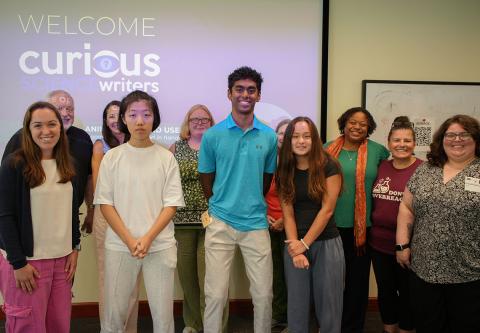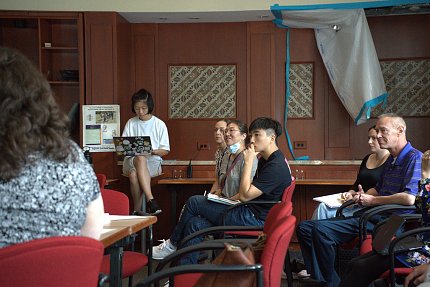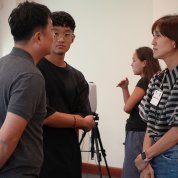Scribes in Training
‘Curious Science Writers’ Visit NIH Campus

Photo: Mahelate Solomon
A new generation of science writers visited campus on July 18. The aptly named Curious Science Writers visited with researchers, science writers and staff from the Office of Animal Care and Use (OACU) and the National Institute of Dental and Craniofacial Research (NIDCR).
Curious Science Writers (cSw) is a program for high school students hosted by Americans for Medical Progress (AMP). The young people are paired with their own science communicator/writer mentor, and research and write their own article with the mentor’s guidance. Mentors are volunteers and hail from various organizations across the country, including NIH.
High school students Olivia Wood, Cindy Lin and Pranav Boreddy visited NIH as part of a week-long boot camp of activities intended to prepare them to embark on their own science writing journey. The day’s events were also opened to student interns from NIDCR (Activities were hosted in Bldg. 30, home of the institute).
Students listened to guest lectures in the morning and toured an animal facility after lunch. The list of presenters included Angela Szwec, OACU program analyst; Tiffany Chen, a science writer at NIDCR; Dr. Brenda Klaunberg, animal imaging program director at the National Institute of Neurological Disorders and Stroke (NINDS); NIDCR biologist Lynn Vitale-Cross; Dr. Lauren Davidson, director of the NIDCR veterinary resources core; and NIDCR facility manager David Mallon.
Chen, a science writer with the Science Communication and Digital Outreach Branch at NIDCR, regaled her audience with a tale about noticing an inaccuracy in her local newspaper when she was in high school. She doubted herself at first—she was “just a kid,” and surely the writer had checked their facts, she thought. The next day, however, the newspaper printed a correction that confirmed her suspicions.

Photo: Mahelate Solomon
“Adults aren’t always right,” Chen reminded her audience. Young people are capable and should value their own unique perspective as budding writers.
An oft-repeated bit of advice from speakers was to use storytelling to make complex subject matter easier to understand. Vitale-Cross emphasized that point in her presentation. As a biologist conducting research in the adult stem cell section of Dr. Eva Mezey’s lab, her research is both fascinating and complicated.
“You have to tell a clear and concise narrative in order to tell your science story,” Vitale-Cross said.
Wood, Lin, Boreddy and the rest of their cSw peers now have the rest of the summer to write and polish their respective articles. The finished work will be published on https://curioussciencewriters.org.
To read about cSw visits in previous years, go to go.nih.gov/yvaZAjz and https://go.nih.gov/lWhQHQu.


